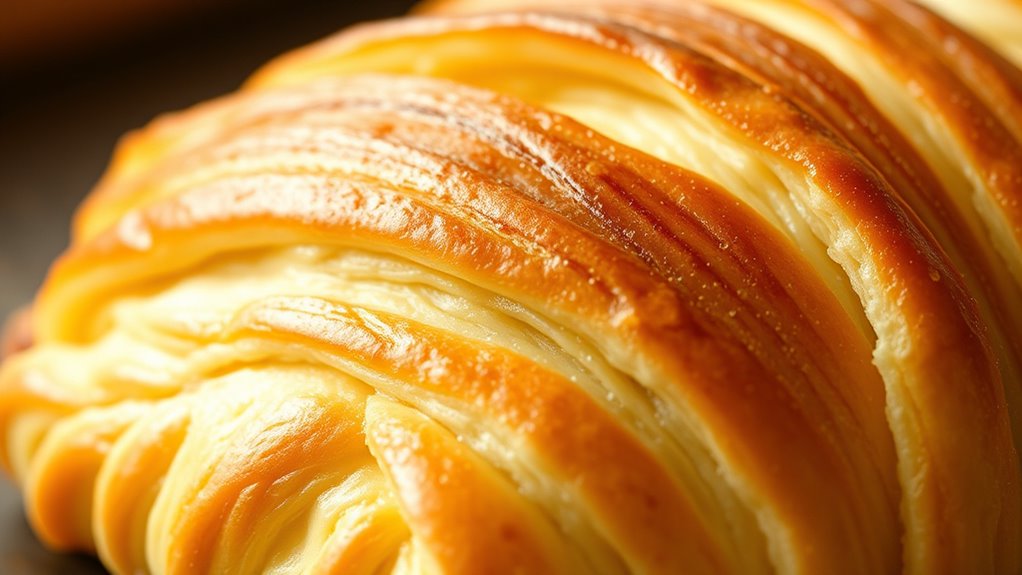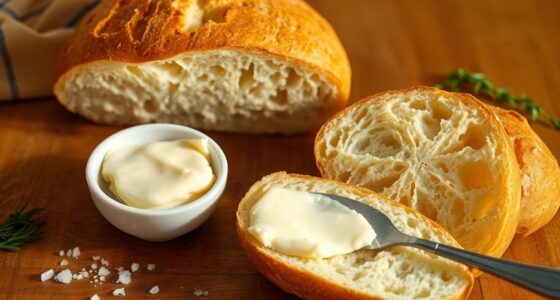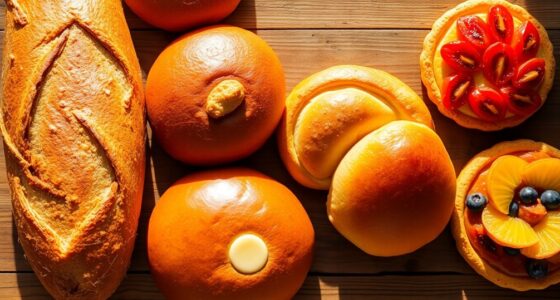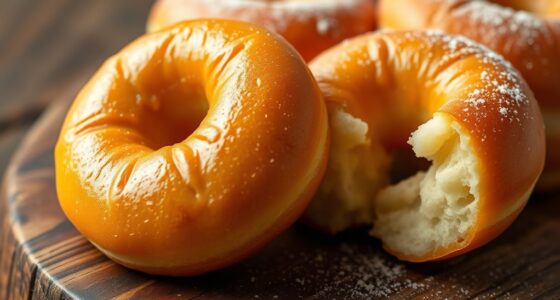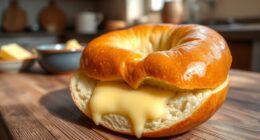To make foolproof puff pastry, keep everything cold—chill your butter, dough, and workspace to prevent melting. Use ice water for mixing and work quickly to maintain temperature. Properly chilling your dough before baking allows steam to form between layers, creating flakiness. Controlling oven heat ensures even baking and ideal butter melt. Master these temperature tricks, and you’ll gain access to bakery-quality layers that are flaky and perfect every time; learn the expert secrets to elevate your puff pastry skills.
Key Takeaways
- Keep butter and ingredients cold, ideally chilled or frozen, to prevent melting and ensure flaky layers during rolling and baking.
- Use ice water when mixing dough to activate gluten without softening butter, maintaining the dough’s firm and workable consistency.
- Chill the dough thoroughly (30 minutes to 1 hour) before rolling to preserve butter layers and improve flakiness.
- Work quickly in a cool environment, using chilled surfaces or marble slabs, to prevent butter from softening during folding and shaping.
- Bake at a high, preheated temperature (around 400°F/200°C) to promote steam formation and achieve crisp, layered puff pastry.
The Importance of Cold Ingredients
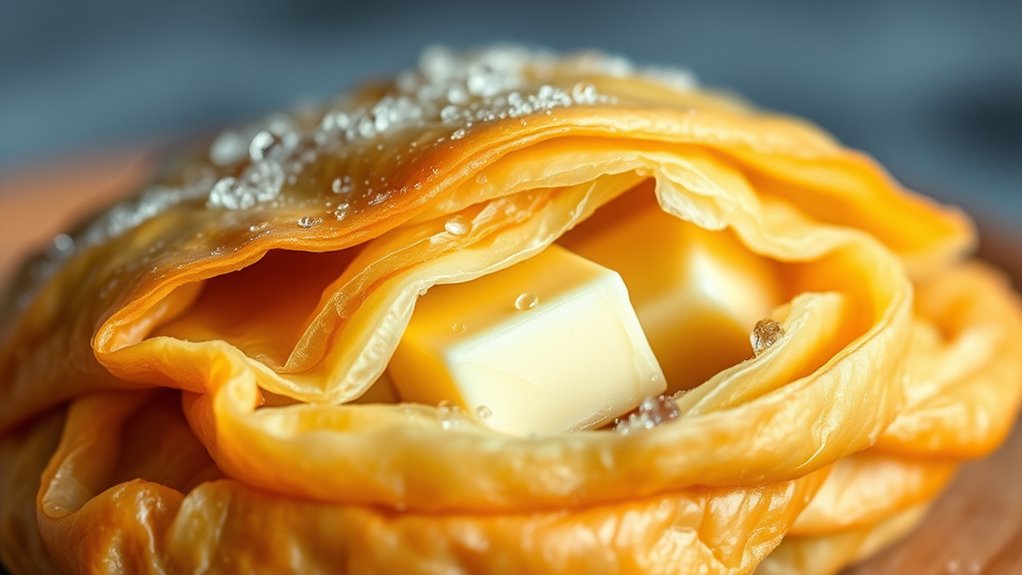
To achieve perfectly flaky puff pastry, you need to start with cold ingredients. The key is maintaining the right butter consistency—cold but not hard—so it layers smoothly without melting into the dough. Proper storage techniques are vital; keep your butter chilled until you’re ready to work with it. If butter warms up, it loses its ability to create those delicate, airy layers. When preparing your ingredients, resist the temptation to leave butter out at room temperature. Instead, store it in the fridge and only take it out when you’re ready to incorporate it into your dough. Cold ingredients help guarantee your pastry remains light and flaky, giving you professional results every time. Additionally, understanding the role of temperature control in pastry making can help you fine-tune your process for optimal layering and texture.
Chilling Your Dough Properly
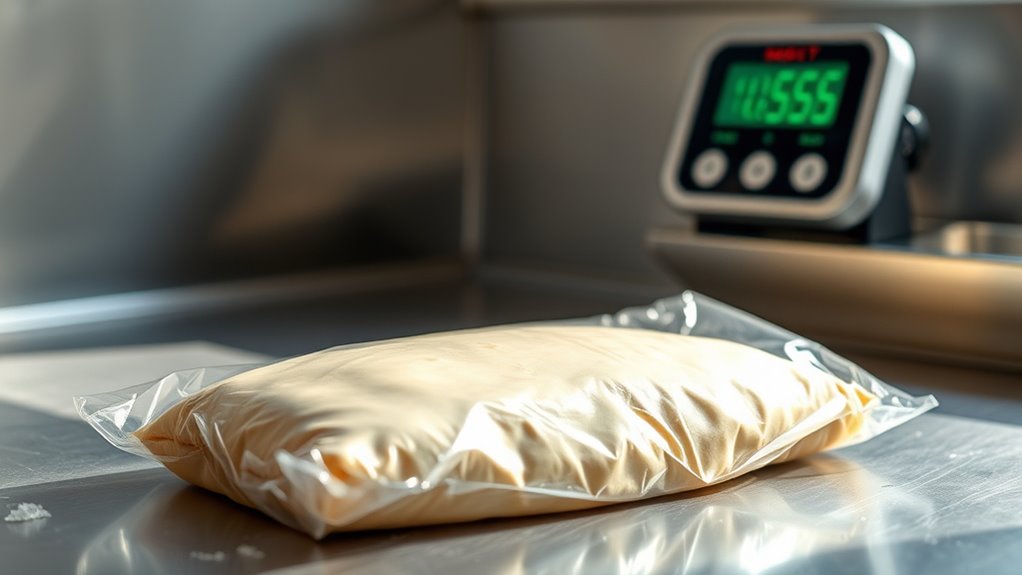
Make sure to chill your dough until it’s firm enough to handle easily. Using a cold surface while rolling helps maintain the right temperature and prevents melting. Proper chilling guarantees your puff pastry stays flaky and rises perfectly. Additionally, keeping the dough cold supports the integrity of the layers, similar to how ketosis relies on maintaining a specific metabolic state for optimal results.
Chill Until Firm
Chilling your puff pastry dough until it’s firm is essential for achieving flaky, layered results. When the dough firms up, it becomes easier to handle, and its dough elasticity improves, allowing you to roll and fold without tearing. Proper chilling also enhances flavor, giving the butter time to meld with the flour for a richer taste. If you skip this step or rush the process, the dough may become too soft, making it difficult to work with and risking uneven layers. Keep the dough in the fridge until it’s firm to the touch, usually about 30 minutes to an hour. Using a self wateringsystem can help maintain consistent moisture levels in your workspace, ensuring your dough remains at the perfect texture. This step ensures your puff pastry will bake up crisp, flaky, and perfectly layered every time.
Use Cold Surfaces
Ensuring your work surface stays cold during the rolling and folding process helps maintain the dough’s temperature and prevents the butter from melting. Using cold surfaces or frozen workspaces keeps the dough firm and layered properly. When your countertop or pastry board is chilled, it slows butter melting, ensuring flaky layers form perfectly. To keep surfaces cold, chill your work area or place a marble slab in the freezer beforehand. This prevents warmth transfer from your hands or environment. Here’s a quick comparison:
| Cold Surfaces | Frozen Workspaces |
|---|---|
| Keep dough cold | Freeze workspace ahead |
| Use chilled tools | Use frozen marble slabs |
| Maintain consistent temperature | Prevent butter melting |
| Reduce softening | Enhance flaky layers |
| Ideal for rolling | Best for folding |
Using cold surfaces is key to foolproof puff pastry. Additionally, understanding the importance of temperature control can make all the difference in achieving perfect flaky layers.
The Role of Temperature in Layer Formation
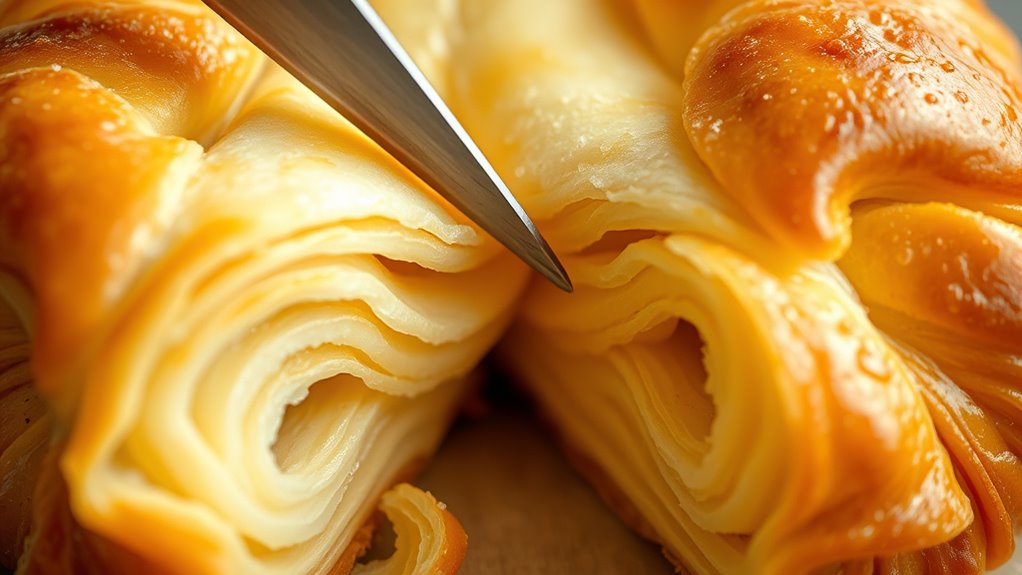
Temperature plays a crucial role in how puff pastry layers develop, as it directly affects the integrity of the butter and dough during the baking process. When the oven temperature is just right, the butter melts evenly, creating steam that pushes apart the dough layers, forming those flaky layers you want. If the oven is too hot, the butter may melt too quickly, causing uneven layers or a greasy crust. Conversely, if it’s too cool, the layers won’t rise properly, resulting in dense pastry. Maintaining the right oven temperature ensures your butter maintains ideal consistency during baking, promoting consistent steam generation and perfect layer separation. Oven temperature control is essential for achieving consistent results, as it influences how the butter behaves and how the layers develop. Precision in oven heat helps you achieve that crisp, airy, and perfectly layered puff pastry every time.
Maintaining a Cold Workspace
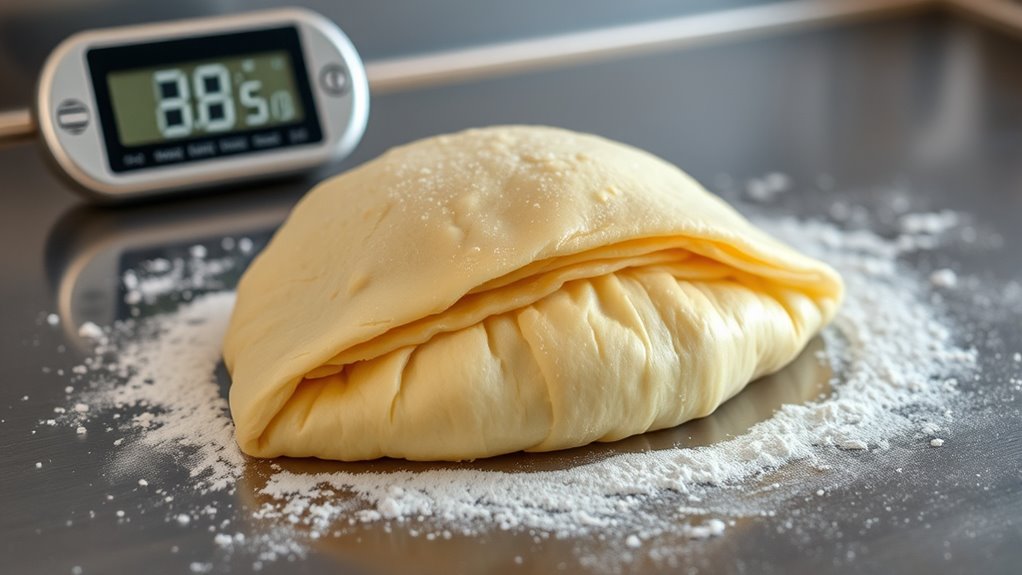
Keeping your workspace cold is key to flaky puff pastry. Use cold ingredients and chill your utensils regularly to make certain of melting butter. A chilly environment ensures the layers stay distinct and tender. Incorporating temperature control techniques can further improve the pastry’s texture.
Keep Workspace Chilly
To prevent your puff pastry from becoming too soft or sticky, maintaining a chilly workspace throughout the process is vital. Use baking equipment like a marble countertop or chilled pastry boards to keep the temperature low. Make certain your workspace stays cool by working in an air-conditioned room or periodically wiping down surfaces with a cold cloth. Proper ingredient sourcing also plays a role; keep ingredients refrigerated until just before use. Avoid warm utensils or hands, as heat can transfer quickly, softening the dough. By keeping your workspace chilled, you help maintain the dough’s structure, making it easier to fold and roll without sticking or melting. This simple step ensures your puff pastry stays crisp, flaky, and perfect every time.
Use Cold Ingredients
Have you ever noticed how warm ingredients can cause puff pastry to become too soft or sticky? Using cold ingredients keeps the dough firm and manageable. Cold butter, in particular, maintains its consistency, creating flaky layers when folded. To help visualize, consider this table:
| Ingredient Temperature | Effect on Puff Pastry |
|---|---|
| Cold butter | Flaky, layered texture |
| Room temperature butter | Tough, less flaky |
| Cold water | Easier handling, less stickiness |
Maintaining a cold workspace and ingredients helps control the dough’s consistency. If ingredients are warm, the butter melts prematurely, making it harder to achieve the desired rise. Keep everything chilled to ensure your oven temperature can do its job, resulting in perfect, puffy layers. Proper temperature control is essential for professional-level pastry results.
Chill Utensils Regularly
Using cold ingredients is a great start, but maintaining a consistently cold workspace is just as important. Regularly chilling your utensils helps prevent heat transfer that can soften the dough. Before working, sterilize your tools and place them in the refrigerator or freezer. Cold utensils ensure your pastry stays crisp and layers remain distinct. Keep your oven temperature precise, as a consistent heat ensures proper puffing. When handling the dough, frequently cool your hands and tools to avoid warming the butter layers. This practice reduces the risk of melting fat and compromising flakiness. Additionally, understanding the importance of frozen ingredients helps you better maintain optimal conditions for perfect puff pastry. By keeping everything cold, including your utensils, you help maintain the perfect environment for puff pastry to rise beautifully and develop that irresistible, flaky texture.
Using Ice Water for Flakiness

Incorporating ice water into your puff pastry dough is vital for achieving maximum flakiness. Cold water helps maintain the butter’s ideal consistency, preventing it from melting and blending too fully into the dough. This keeps the dough temperature low, which is essential for creating distinct, flaky layers. When you add ice water carefully, you activate gluten just enough for cohesion without overworking the dough. The cold temperature also ensures the butter stays firm, creating steam pockets that puff up during baking.
- Keeps butter firm for distinct layers
- Maintains low dough temperature
- Prevents butter from melting too early
- Promotes even hydration of flour
- Enhances flakiness and structure
How to Handle Butter for Perfect Layers
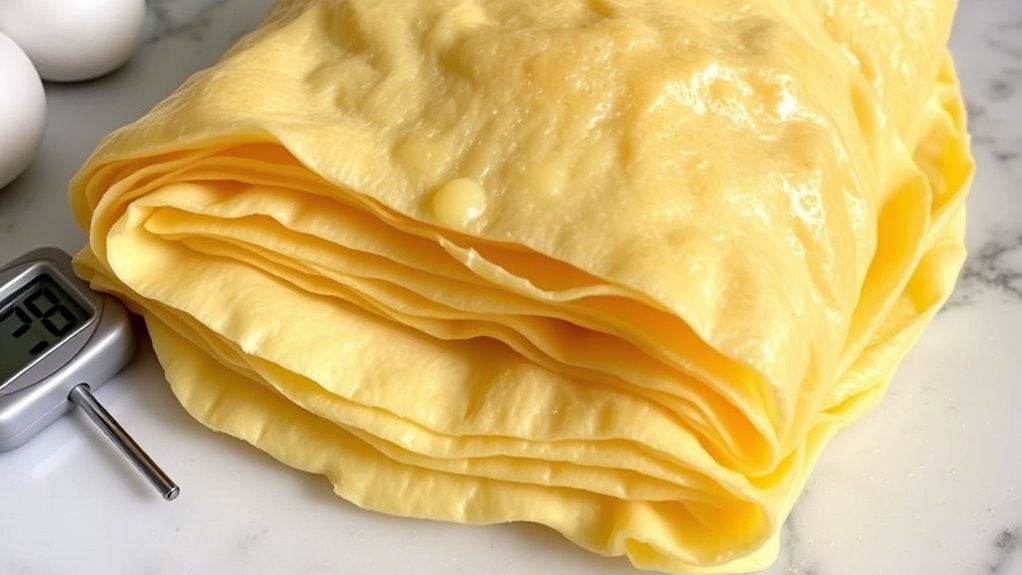
Handling butter correctly is key to creating those iconic flaky layers in puff pastry. You want your butter to be cold but pliable enough to incorporate smoothly. Use high-quality butter to enhance the butter flavor, which adds richness and depth to your pastry. When rolling out the dough, keep the butter evenly distributed to ensure consistent layers. Avoid overworking the dough, as this can melt the butter and ruin the pastry’s aesthetics. Instead, work quickly and confidently, folding the dough to create multiple thin layers. Properly managed butter ensures your puff pastry achieves the perfect balance of flakiness and tenderness, making it visually appealing and delicious. Additionally, headphone compatibility can be affected by the device you choose, so selecting the right type ensures seamless audio experience. Mastering this step gives your pastry the professional look and taste everyone loves.
Troubleshooting Temperature-Related Puff Pastry Failures
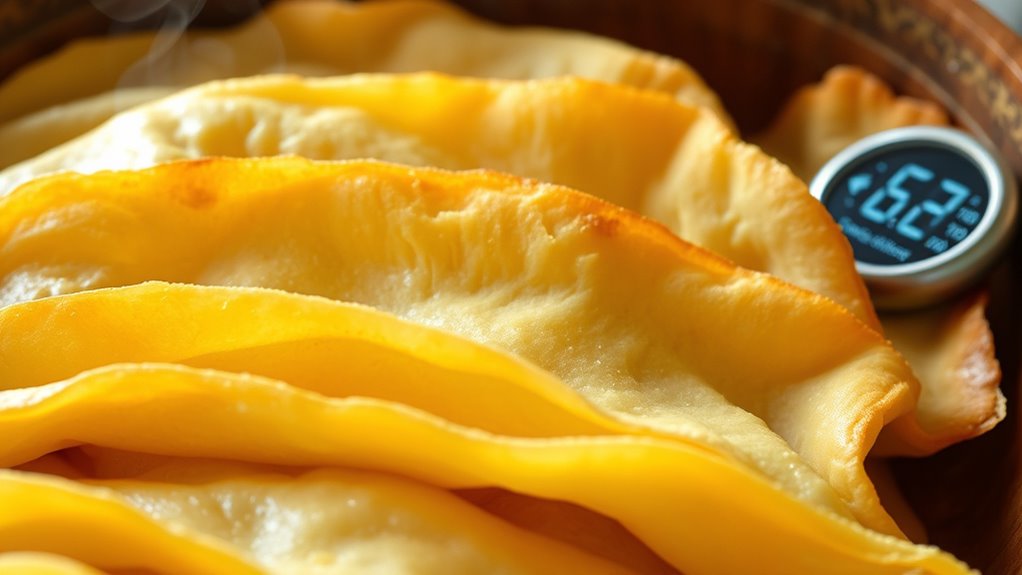
Temperature issues are a common cause of puff pastry failures, often resulting in uneven layers, excessive spreading, or a lack of flakiness. To troubleshoot, start by checking your oven calibration—an inaccurate oven can throw off your baking temp and ruin your layers. If your recipe calls for ingredient substitution, verify you adjust for temperature differences; for example, using butter instead of shortening may require slight temp adjustments. Additionally, remote hackathons can be a great way to learn new baking techniques from experts around the world.
Frequently Asked Questions
Can I Use Room Temperature Ingredients for Puff Pastry?
You can use room temperature ingredients for puff pastry, but it’s best to keep the dough cold to guarantee flaky layers. Proper ingredient preparation involves chilling butter and liquids to maintain the right dough temperature. If ingredients are too warm, the butter melts, making it harder to achieve those delicate layers. Keep everything cool during mixing and handling to help the dough stay firm and yield perfect puff pastry results.
How Does Humidity Affect Puff Pastry Temperature Techniques?
Humidity impacts puff pastry by adding moisture, making the dough stickier and harder to handle. To regulate moisture, you should adjust your temperature techniques accordingly, like chilling the dough more or working in a cooler environment. Proper moisture control is key to achieving flaky layers, especially in humid conditions. Keep an eye on humidity levels, and don’t rush the process—this way, you’ll ensure perfect, crisp puff pastry every time.
What Are Signs of Temperature Issues During Baking?
You’ll notice temperature issues during baking if your puff pastry doesn’t rise properly or turns out greasy and dense. Check your oven calibration regularly, as inaccurate temperatures can cause these problems. Also, confirm your ingredients are fresh; old butter or flour can affect how well the pastry puffs. These signs indicate it’s time to verify your oven’s accuracy and ingredient quality for consistently perfect results.
Can I Freeze Puff Pastry Dough Without Compromising Temperature?
You can freeze puff pastry dough without compromising its temperature if you use proper freezing techniques. Wrap the dough tightly to maintain its dough consistency and prevent freezer burn. When ready to use, thaw it slowly in the fridge to keep the temperature stable. This way, you preserve its flakiness and texture, ensuring your puff pastry turns out perfect every time without sacrificing quality.
How Do I Adjust Techniques for Different Oven Types?
Like adapting to different weather, adjusting for various ovens is key. You should check your oven calibration regularly for accuracy. For even baking, consider using baking stone techniques if your oven runs hot or cold. If your oven’s heat differs, tweak the temperature slightly and monitor closely. Remember, each oven is unique, so experiment with small adjustments until you find the perfect setting for puff pastry perfection.
Conclusion
So, next time your puff pastry flops, just remember: it’s all about temperature. Keep your ingredients icy, your workspace cooler than your ex’s heart, and handle that butter like it’s fragile royalty. Master these tricks, and you’ll impress everyone—without needing a PhD in pastry science. Because, really, if you can keep things cold, you’re practically a pastry wizard. Now go forth and conquer that flaky, buttery masterpiece—hot messes be damned!
